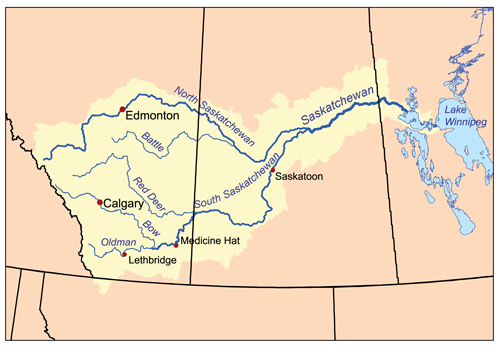
Course
The Saskatchewan River is formed by the confluence of the North and South Saskatchewan rivers, the headwaters of which are in the Rocky Mountains. The North and South Saskatchewan follow a roughly parallel path until the South Saskatchewan passes through Medicine Hat, Alberta, where it shifts northeast until it reaches the North Saskatchewan, just east of Prince Albert, Saskatchewan. From The Forks, the newly formed Saskatchewan River flows east to Tobin Lake, a reservoir formed by the E.B. Campbell Dam, then enters the river delta (also called Cumberland Marshes), past Cumberland House and across the Saskatchewan-Manitoba border, through The Pas, and empties into Cedar Lake.
Flora and Fauna
The Saskatchewan River delta is the largest inland freshwater delta in North America and home to an abundance of mammals, including elk, white-tailed deer, black bear, muskrat, beaver, mink, otter, lynx and wolf, as well as over 200 species of birds, such as mallard, ring-necked duck, blue-winged teal, canvasback and Canada goose. It’s also home to 48 species of fish, including walleye, northern pike and the endangered lake sturgeon. Due to the large variety of species as well as populations of waterfowl, the delta, along with Tobin Lake, has been designated as important waterfowl habitat. Other wetlands throughout the Saskatchewan River basin also provide essential habitats for waterfowl.
Environmental Concerns
Water quality of the Saskatchewan River is largely a function of the upstream tributaries — the North and South Saskatchewan rivers — both of which flow through urban centres and highly productive agricultural areas, picking up contaminants such as fertilizers, pesticides and municipal wastewater. The North and South Saskatchewan rivers are also highly regulated by hydroelectricity-producing dams and reservoirs, as well as diversions for irrigation. Additionally, there are three hydroelectric dams on the Saskatchewan River, two at Tobin Lake in eastern Saskatchewan, the Nipawin Hydroelectric Station and the E.B. Campbell Dam, and the Grand Rapids Generating Station at the end of the Saskatchewan Delta, between Cedar Lake and Lake Winnipeg. The presence of dams and associated water regulation has led to a decrease in the frequency of flooding to wetlands and marshes in the delta. This decrease is considered problematic, as floods normally recharge the wetlands by depositing nutrients.
History
Indigenous peoples have inhabited the Saskatchewan River basin for over 10,000 years and the river served as a major east-west transportation route.The basin includes the traditional territories of the Blackfoot Confederacy to the west, the Assiniboine (primarily south of the river), Cree, Ojibwa and Métis. The Assiniboine and Cree were instrumental in early European exploration and the fur trade.
In 1690–92, Henry Kelsey, a Hudson’s Bay Company (HBC) employee, became the first European to explore the Saskatchewan River, although the HBC ultimately ignored the river until Anthony Henday, another employee, set out to expand trade into the upper basin in 1754. The first in a series of trading posts on the Saskatchewan, Fort Paskoyac, at present day The Pas, was built by Louis-Joseph de La Vérendrye in 1750. Cumberland House, built in 1774 by Samuel Hearne on the lower Saskatchewan, was HBC’s first inland trading post and the oldest permanent settlement in Saskatchewan. A rivalry between the French and HBC traders existed throughout the fur trade. In addition, the fur trade had negative impacts on the lifestyles of First Nations, including the introduction of European diseases such as smallpox, measles and scarlet fever, outbreaks of which decimated First Nations populations.

 Share on Facebook
Share on Facebook Share on X
Share on X Share by Email
Share by Email Share on Google Classroom
Share on Google Classroom

